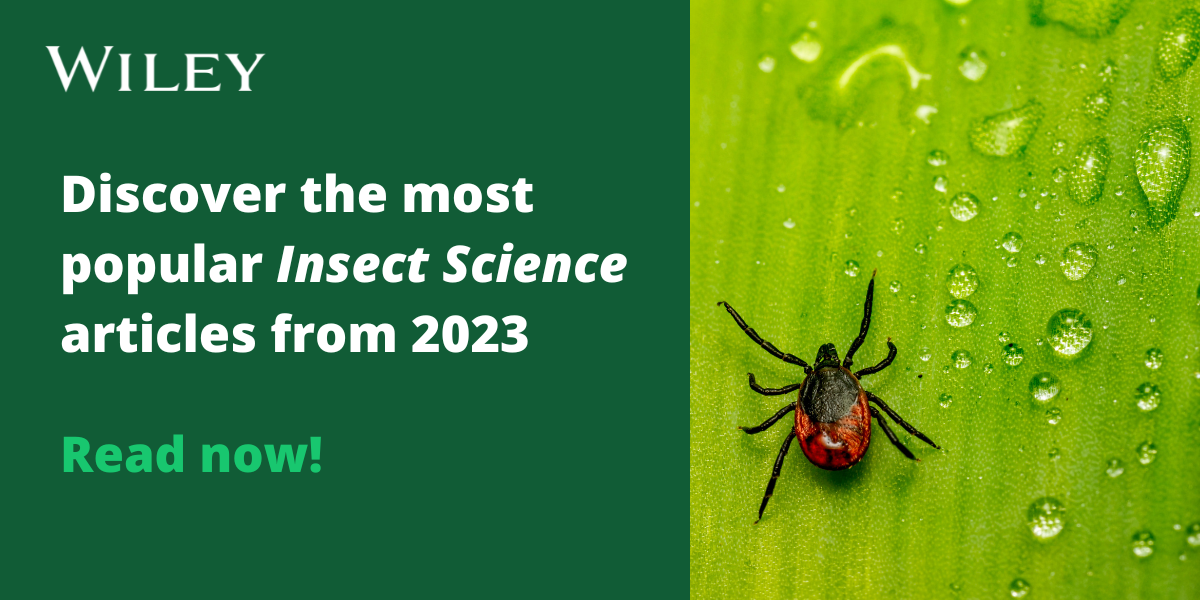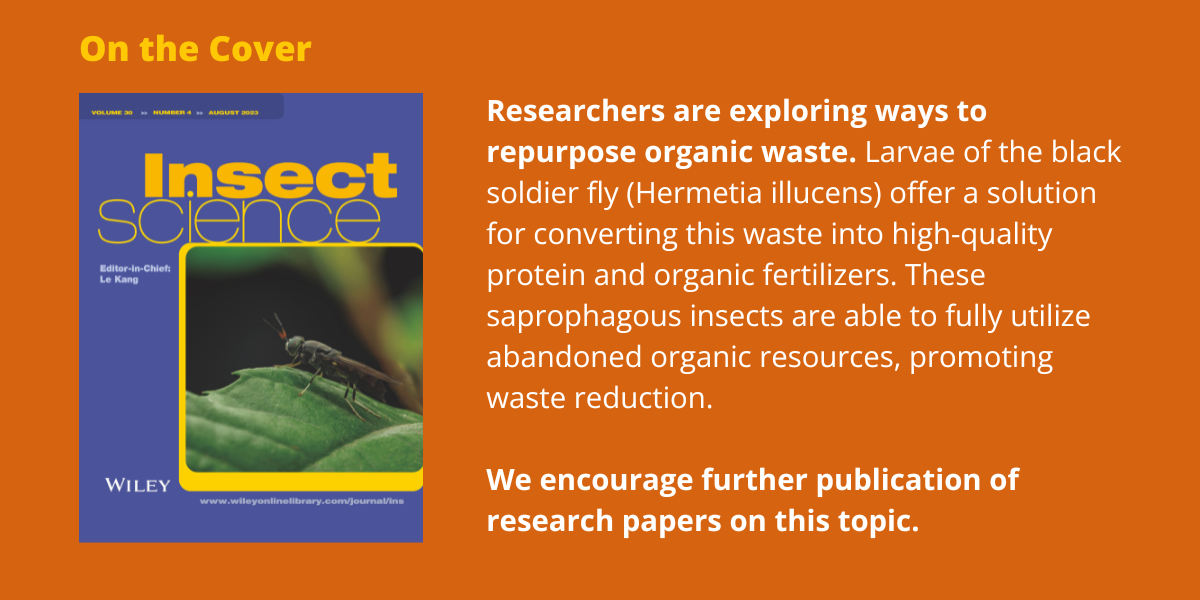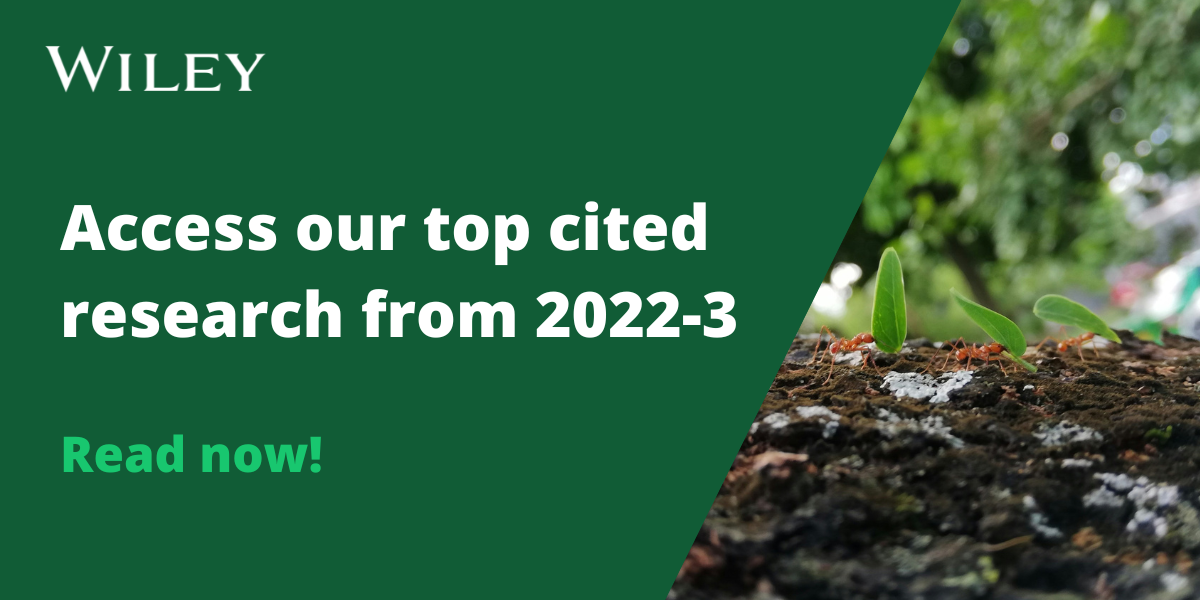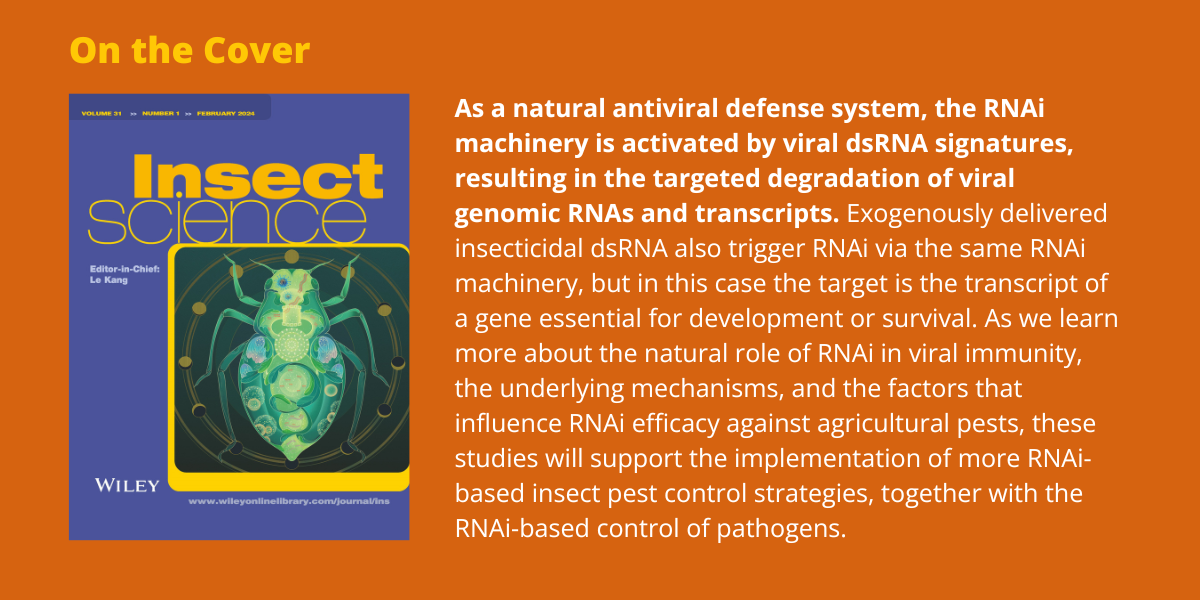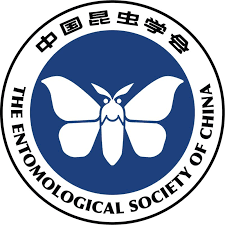Editor-in-Chief: Le Kang
Journal list menu
About the Journal
Insect Science publishes entomology research spanning the behavior, biogeography, ecology, genomics, molecular biology, physiology, biochemistry, sociobiology, phylogeny, exotic incursions and pest management of insects and other terrestrial arthropods. Our emphasis is on the adaptation and evolutionary biology of insects from the molecular to the ecosystem level.
Why Publish in Insect Science?
- Ranked in the top 15% of entomology journals worldwide (Journal Citation Reports, Clarivate)
- Fully open access publishing helps your research find its audience, and achieve more downloads and citations
- Easy submission and rapid publication processes
- Annual awards for most cited papers recognise high impact research
Articles
Genome-wide identification of yellow gene family in Hermetia illucens and functional analysis of yellow-y by CRISPR/Cas9
- 29 April 2024
Graphical Abstract

We first manually annotated and curated 10 yellow genes in the black soldier fly, Hermetia illucens. Mutation of yellow-y clearly resulted in a pale-yellow body colour of prepupae, pupae and adults, instead of the black body colour seen in the wild type. However, no color difference was observed in cuticle pigmentation between wild-type and yellow-c or yellow-f mutant insects.
Dual roles of α1,4-galactosyltransferase 1 in spermatogenesis of Drosophila melanogaster
- 21 April 2024
Graphical Abstract

Xiao et al. identified functions of α1,4-galactosyltransferase 1 (α4GT1) in spermatogenesis of Drosophila melanogaster. They found that α4GT1 was expressed at a significantly higher level in the testis than in the ovary of Drosophila, and that the hatching rate was significantly decreased when α4GT1 RNAi males were crossed with w1118 females, with only a few mature sperm present in the seminal vesicle of α4GT1 RNAi flies. They further showed that the individualization complex (IC) in the testes of α4GT1 RNAi flies was scattered and did not move synchronically, compared with the clustered IC observed in control flies, and that the apoptosis signals in the sperm bundles of α4GT1 RNAi flies were significantly increased. Moreover, they found that the expression of several individualization-related genes, such as Shrub, Obp44a and Hanibi was significantly decreased, whereas the expression of several apoptosis-related genes, including Dronc and Drice, was significantly increased in the testes of α4GT1 RNAi flies. Their results suggest that α4GT1 may play dual roles in Drosophila spermatogenesis by regulating the sperm individualization process and maintaining the survival of sperm bundles.
The gut microbiome promotes locomotion of Drosophila larvae via octopamine signaling
- 21 April 2024
Strong resistance to β-cyfluthrin in a strain of the beetle Alphitobius diaperinus: a de novo transcriptome analysis
- 17 April 2024
Disruption of Zfh3 abolishes mulberry-specific monophagy in silkworm larvae
- 15 April 2024
Graphical Abstract

Disruption of Zfh3 affects both gustation and olfaction of silkworm larvae. Heterozygous Zfh3 knockout larvae lose preference for mulberry leaves, acquire the ability to consume an expanded range of diets, and exhibit improved adaptation to the M0 artificial diet, which contains no mulberry leaves. Our results provide the first demonstration that a transcription factor modulates feeding habits in an insect.
Enhancement of fruit byproducts through bioconversion by Hermetia illucens (Diptera: Stratiomyidae)
- Insect Science
- 991-1010
- 26 November 2022
Graphical Abstract

Different byproducts (strawberry, tangerine, orange) from the fruit chain were used as substrates to feed Hermetia illucens larvae. Larvae can feed on all the tested diets, although development time, growth rate, final larval biomass and of macro- and micronutrients are impacted by different substrates.
Bumblebees with the socially transmitted microbiome: A novel model organism for gut microbiota research
- Insect Science
- 958-976
- 14 May 2022
Graphical Abstract

Bumblebees as a model organism for gut microbiota studies. The gut microbiota of bumblebee is simple and specific and has numerous parallels to the human gut microbiota. Bumblebee colonies are available for experiments year-round and keeping indoors. Gnotobiotic bees can be easily generated in the lab, which facilitates the research of interactions between gut microbiota and the host. A set of established methods for quantifying bumblebee behaviors enable us to investigate the mechanism of microbiota-gut-brain communication. Mother-to-child vertical inheritance of gut bacteria exists in newly established bumblebee nests. The unique social life cycle of bumblebees provides new opportunities to study vertical transmission.
Dynamics of the intestinal bacterial community in black soldier fly larval guts and its influence on insect growth and development
- Insect Science
- 947-963
- 11 July 2022
Graphical Abstract
 Graphical Abstract
Graphical Abstract
Analysis of the intestinal bacterial community composition of Hermetia illucens (black soldier fly, BSF) larvae (BSFL) with pyrosequencing showed that the dynamics of bacterial community composition among different larval instars were striking at the genus level. Klebsiella, Clostridium, Providencia, Dysgonomonas, Dysgonomonas, and Providencia were the relatively most abundant bacterial groups in the 1st- to 6th-instar BSFL, respectively. Providencia, Citrobacter, Klebsiella, Ochrobactrum, and Dysgonomonas promoted the growth and development of BSF significantly compared with the germ-free control by increasing the weight gain of larvae and pupae, as well as the prepupae rate and eclosion rate. In addition, Citrobacter, Klebsiella, and Providencia could shorten the life cycle of BSF significantly.
Expression profile of CYP402C1 and its role in resistance to imidacloprid in the whitefly, Bemisia tabaci
- Insect Science
- 146-160
- 23 May 2022
Graphical Abstract
 Graphical Abstract
Graphical Abstract
CYP402C1 was mainly distributed in the midguts of the nymphs and adults of Bemisia tabaci, especially in the filter chamber. Knockdown of CYP402C1 in the resistance population significantly decreased the resistance of B. tabaci to imidacloprid. Overexpression of CYP402C1 in a transgenic Drosophila melanogaster line significantly increased the resistance to imidacloprid.
lncR26319/miR-2834/EndophilinA axis regulates oogenesis of the silkworm, Bombyx mori
- Insect Science
- 65-80
- 25 May 2022
Graphical Abstract

Vitellogenesis, the timely production and uptake of yolk proteins, is essential for female fecundity. In the silkworm, Bombyx mori, a nucleus-enriched long-noncoding RNA (lncRNA) lncR26319 regulates Endophilin A (EndoA), a member of the endophilin protein family of endocytosis, by competitively binding to miR-2834. The lncR26319-miR-2834-EndoA axis contributes to the endocytic activity in the yolk uptake process and leads to the normal progression of oogenesis in the silkworm.
MicroRNA miR-2765-3p regulates reproductive diapause by targeting FoxO in Galeruca daurica
- Insect Science
- 279-292
- 22 June 2022
iVenomDB: A manually curated database for insect venom proteins
- Insect Science
- 264-266
- 28 May 2022
Silencing of V-ATPase-E gene causes midgut apoptosis of Diaphorina citri and affects its acquisition of Huanglongbing pathogen
- Insect Science
- 1022-1034
- 8 November 2022
Graphical Abstract

When silencing the V-ATP-E gene of Asian citrus psyllid adults, the fluorescence signal of Huanglongbing pathogen in their midgut was significantly stronger than that of control group, which indicated that knockdown of V-ATP-E can affect CLas passing through the midgut and into the hemolymph of psyllid host.
The frequency of wing damage in a migrating butterfly
- Insect Science
- 1507-1517
- 26 November 2022
Graphical Abstract
 Graphical Abstract
Graphical Abstract
Annually, the butterfly Vanessa cardui migrates over at least 4000 km. In June and July, these butterflies annually arrive in Germany.
To understand the influence of wing structure on wing damage and mechanisms that might mitigate wing damage, we examined the frequency of wing damage in Vanessa cardui.
The results show that hindwings experience a greater frequency of damage than forewings and forewings suffered from more serious damage on the lateral margin, while hindwings were more damaged in the trailing margin.
Recent progress in the structural study of ion channels as insecticide targets
- Insect Science
- 1522-1551
- 16 May 2022
Graphical Abstract

Ion channel families, including the ryanodine receptor (RyR), the nicotinic acetylcholine receptor (nAChR), the voltage-gated sodium channel (VGSC), the transient receptor potential (TRP) channel, and the ligand-gated chloride channel (LGCC), serve as primary targets of many small-molecule insecticides. The recent progress in the structural biology of insecticide target ion channels has provided many valuable insights into the mechanisms of actions and insecticide resistance, and also provide guidance for designing more selective insecticides.
Chitinase 6 is required for procuticle thickening and organ shape in Drosophila wing
- Insect Science
- 268-278
- 17 September 2022
Graphical Abstract
 Graphical Abstract
Graphical AbstractThe chitin modifying enzyme chitinase 6 (Cht6) is needed to ensure a critical thickness of the cuticle; reduced cuticle thickness in wings with suppressed Cht6 expression causes wing deformation. Probably as a consequence, cuticle permeability to xenobiotics is enhanced in Cht6-less wings.
RNA interference in insects: the link between antiviral defense and pest control
- Insect Science
- 2-12
- 10 May 2023
Graphical Abstract
The transcriptomic signature of responses to larval crowding in Drosophila melanogaster
- Insect Science
- 539-554
- 17 September 2022
Female ticks (Ixodes scapularis) infected with Borrelia burgdorferi have increased overwintering survival, with implications for tick population growth
- Insect Science
- 1798-1809
- 5 May 2023
Graphical Abstract

We demonstrate that adult ticks (Ixodes scapularis) infected with Borrelia burgdorferi, the bacterium that causes Lyme Disease, have greater overwintering survival than uninfected ticks.
Adult ticks were placed in individual microcosms and allowed to overwinter. In the spring we collected the ticks and tested both dead and living ticks for B. burgdorferi DNA. We also performed lab tests to show that we could accurately identify B. burgdorferi DNA in ticks 10 weeks after their death. The study was repeated over 3 years, and infected ticks were more likely to survive the winter than uninfected ticks in each of the 3 winters in two different microclimates (i.e., dune grass and forest). Increased overwintering survival of infected ticks will lead to an enrichment of infected adult ticks in the early spring relative to the fall, and this has important public health implications. Moreover, the increased winter survival of adult female ticks could have a large impact on tick population growth. Our results suggest that, in addition to climate change, B. burgdorferi infection itself may be promoting the northern range expansion of I. scapularis. This is a novel insight. Our study highlights how pathogens could promote host range expansion.
Multiple mating by both sexes in an invasive insect species, Aethina tumida (Coleoptera: Nitidulidae)
- Insect Science
- 517-529
- 12 September 2022
Graphical Abstract
 Graphical Abstract
Graphical Abstract
In an invasive population in the United States, a combination of laboratory experiments for males and paternity analysis with eight polymorphic DNA microsatellite markers for field-caught females was used to estimate the number of mating by both sexes. Our data clearly show for the first time that both male and female small hive beetles are commonly mating with multiple partners and that paternities can be skewed.
Multiple endocrine factors regulate nutrient mobilization and storage in Aedes aegypti during a gonadotrophic cycle
- Insect Science
- 425-442
- 2 September 2022
Graphical Abstract

Aedes aegypti and other anautogenous mosquito species produce eggs in sequential gonadotrophic cycles that are subdivided into a sugar-feeding previtellogenic phase that produces primary follicles and a blood-meal activated vitellogenic phase in which primary follicles mature into eggs that females lay. In this study, Dou et al. report Ae. aegypti females rapidly mobilize triacylglycerol and glycogen nutrient stores in the fat body during the vitellogenic phase, which are then replenished. Functional assays indicate that adipokinetic hormone (AKH) mobilizes triacylglycerol and glycogen stores while twenty hydroxyecdysone (20E) also exhibits weak triacylglycerol mobilizing activity. In contrast, juvenoids, ovary ecdysteroidogenic hormone (OEH) and insulin-peptide 3 exhibit functions associated with replenishment of nutrient stores.
Deciphering the cellular heterogeneity of the insect brain with single‐cell RNA sequencing
- Insect Science
- 314-327
- 13 September 2023
Graphical Abstract

Single-cell RNA sequencing (scRNA-seq) has emerged in the past decade and profoundly accelerated our understanding of brain complexity. scRNA-seq has a higher resolution than bulk RNA-seq, which enables novel cell type classification, dynamic trajectory construction, and gene regulatory network identification. To give a general understanding of scRNA-seq application in brain science, we depict a brief overview of the experimental workflow and a typical downstream data analysis in this graphical abstract.
Sublethal exposure to spinetoram impacts life history traits and dengue virus replication in Aedes aegypti
- Insect Science
- 486-500
- 7 September 2022
Graphical Abstract
 Graphical Abstract
Graphical Abstract
Sublethal spinetoram exposure originates Aedes aegypti females with smaller size and weaker blood-feeding capacity; sublethal spinetoram exposure prolonged the immature development period in Ae. aegypti; and sublethal spinetoram exposure dysregulates mitochondrial function and stimulates dengue virus replication both in cells and in female mosquitoes.
Current and future control of the wood-boring pest Anoplophora glabripennis
- Insect Science
- 1534-1551
- 21 March 2023
Graphical Abstract

Anoplophora glabripennis is a devastating wood boring pest native to Asia. This non-native invasive species attacks forests and urban trees in North America and Europe. This review covers recent research concerning distribution and destruction of Asian longhorn beetle (ALB), as well as major efforts to control and manage ALB in China.
Research progress toward the influence of mosquito salivary proteins on the transmission of mosquito‐borne viruses
- Insect Science
- 5 April 2023
Graphical Abstract

Mosquito salivary proteins (MSPs) bear multitudinous functions, embracing facilitating blood feeding and affecting the infection of mosquito-borne viruses (MBVs) via directly interplaying with MBVs or tuning the homeostasis of host cells. In vivo, MSPs can modulate host's innate and adaptive immunity, which in turn impacts the native infection at the bite site and the remote dissemination of MBVs. MSP-based MBV transmission-blocking vaccines are neoteric and effective tactics to stifle the MBV transmission.
Recent issues
Understanding Open Access
Want to publish your article and have everyone read your research?
Watch this video to find out the details of how Open Access with Wiley allows you to comply with funder mandates and to gain greater visibility and impact whilst publishing in your journal of choice. For more information visit: www.wileyonlinelibrary.com/onlineopen





